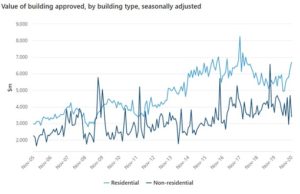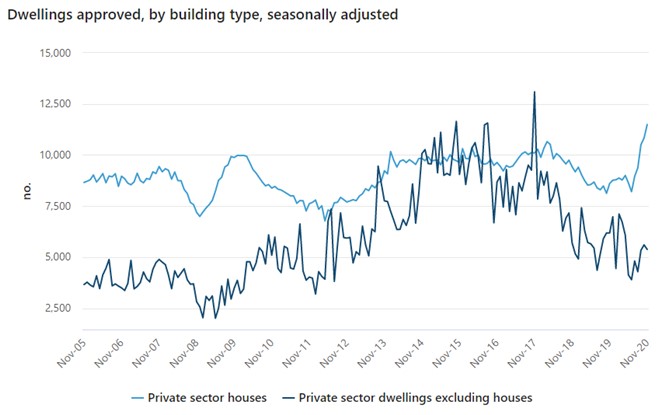- Seasonally adjusted data from the ABS shows total dwellings approved rose by 2.6 per cent in November 2020
- Private sector house approvals rose by 6.1 per cent
- The value of non-residential buildings approved however fell by 27.4 per cent
The seasonally adjusted data released by the Australian Bureau of Statistics (ABS) has shown that private sector house approvals during the month of November have risen again – this time by 6.1 per cent – representing 11,489 private sector homes nationally.
These figures are almost double what was seen in October when private house approvals increased by 3.1 per cent.
The last month private house approvals fell was June 2020 when they saw a decrease of 5.7 per cent.
All the States – excluding Tasmania which does not provide specific data regarding private sector houses– saw increases.
The biggest monthly increase by far was seen in Queensland which saw a 17 per cent jump in the number of private sector house approvals. Western Australia was second place with a 7.5 per cent monthly increase.
In terms of total dwellings, approvals are up by 2.6 per cent with the biggest increase seen in South Australia at 18.8 per cent. This is despite Adelaide’s relatively short lockdown which occurred the same month.
Western Australia, Victoria and Tasmania all saw declines with -5.4, -4.6 and -0.4 per cent declines in dwellings approved respectively.
This upward trend is arguably caused by a variety of factors such as various Federal and State Government incentives and record-low interest rates that are stimulating the overall economy.

Historically the value of buildings approved – especially non-residential – tends to fluctuate quite significantly and November compared to October was no exception.
The value of buildings approved overall fell to $10.09 billion nationally, representing a 8.4 per cent decrease compared to October when the value was $10.88 billion. This is despite residential building values increasing over the same period of time.








